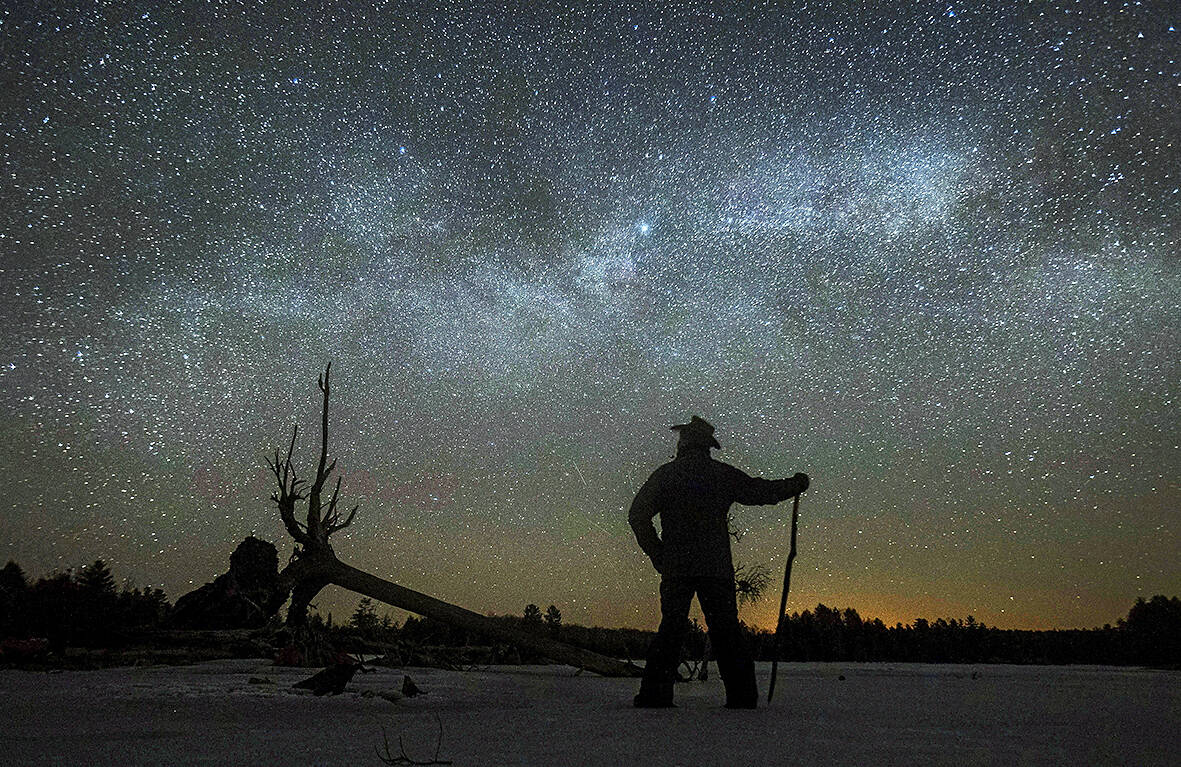A ban on megaconstellations of low-altitude satellites — arrays such as Elon Musk’s Starlink — should be considered, astronomers have said, in an effort to reduce light pollution and preserve our ability to study the skies.
In a series of papers and opinion pieces published in the journal Nature Astronomy, scientists have raised the alarm about the brightening night sky, with one team of experts calling for scientists to stand up to “big light” as they have to other fields, such as big tobacco and big oil, and bring in regulation.
For megaconstellations of low-altitude satellites, they write, this could mean a veto.

Photo: Reuters
“On the scales of immediate or long-term benefits and harm to society, and despite the popularity of satellite megaconstellations, we must not reject the possibility of banning them. On the contrary, we believe that the impacts and risks are too high for this possibility to be ruled out,” they write.
The team say that it is unlikely that bodies contributing to light pollution — be it from ground-based LEDs or other lamps, or low-altitude satellites — will regulate themselves.
“Every time some health or environmental issue arises and starts to be addressed in the scientific literature, the ‘machine of doubt’ is put into action by the polluters to stop, or at least delay by years or decades, the adoption of countermeasures and rules to protect human health and the environment,” write Fabio Falchi, from the Light Pollution Science and Technology Institute in Italy, and co-authors in a comment piece.

Photo: AP
As a result, the team have called for action.
“In my opinion there should be a cap limit on the total number of satellites in low orbits, and their number is probably already too high,” Falchi said, with the team writing that caps should also be introduced for artificial light at night.
According to an accompanying perspective piece, megaconstellations have more than doubled the number of functional satellites in low Earth orbit since early 2019, with a vast number of launches planned in the coming years.
But experts say this has come at a cost: the illumination of the artificial satellites and associated space junk by the sun has increased night sky brightness.
“We are witnessing a dramatic, fundamental and perhaps semi-permanent transformation of the night sky without historical precedent and with limited oversight,” writes John Barentine of Dark Sky Consulting and colleagues.
According the authors, one concern is that faint astrophysical signals will become increasingly hard to detect due to increasing night sky brightness.
“An example with distinct and potentially severe social consequences is the detection of near-Earth objects that represent a high risk of colliding with our planet,” they write.
In addition, the team note that an increase in “noise” can lead to a loss of efficiency and hence a greater financial burden for research facilities due to an increase in the time needed to collect and combine data.
Satellites trails in astronomical images are another problem, while there is also a concern about the impact of increasing night sky brightness on biological systems.
Then there is the impact on the public, who may find it harder to see the Milky Way, familiar constellations, weak aurorae and faint meteors.
Overall, the scientists suggest the stakes are too high for inaction.
“For the general public there is the possibility to lose the natural sight of a perfect natural starry sky, everywhere on Earth,” said Falchi.

In the March 9 edition of the Taipei Times a piece by Ninon Godefroy ran with the headine “The quiet, gentle rhythm of Taiwan.” It started with the line “Taiwan is a small, humble place. There is no Eiffel Tower, no pyramids — no singular attraction that draws the world’s attention.” I laughed out loud at that. This was out of no disrespect for the author or the piece, which made some interesting analogies and good points about how both Din Tai Fung’s and Taiwan Semiconductor Manufacturing Co’s (TSMC, 台積電) meticulous attention to detail and quality are not quite up to

Chinese Nationalist Party (KMT) Chairman Eric Chu (朱立倫) hatched a bold plan to charge forward and seize the initiative when he held a protest in front of the Taipei City Prosecutors’ Office. Though risky, because illegal, its success would help tackle at least six problems facing both himself and the KMT. What he did not see coming was Taipei Mayor Chiang Wan-an (將萬安) tripping him up out of the gate. In spite of Chu being the most consequential and successful KMT chairman since the early 2010s — arguably saving the party from financial ruin and restoring its electoral viability —

It is one of the more remarkable facts of Taiwan history that it was never occupied or claimed by any of the numerous kingdoms of southern China — Han or otherwise — that lay just across the water from it. None of their brilliant ministers ever discovered that Taiwan was a “core interest” of the state whose annexation was “inevitable.” As Paul Kua notes in an excellent monograph laying out how the Portuguese gave Taiwan the name “Formosa,” the first Europeans to express an interest in occupying Taiwan were the Spanish. Tonio Andrade in his seminal work, How Taiwan Became Chinese,

Toward the outside edge of Taichung City, in Wufeng District (霧峰去), sits a sprawling collection of single-story buildings with tiled roofs belonging to the Wufeng Lin (霧峰林家) family, who rose to prominence through success in military, commercial, and artistic endeavors in the 19th century. Most of these buildings have brick walls and tiled roofs in the traditional reddish-brown color, but in the middle is one incongruous property with bright white walls and a black tiled roof: Yipu Garden (頤圃). Purists may scoff at the Japanese-style exterior and its radical departure from the Fujianese architectural style of the surrounding buildings. However, the property